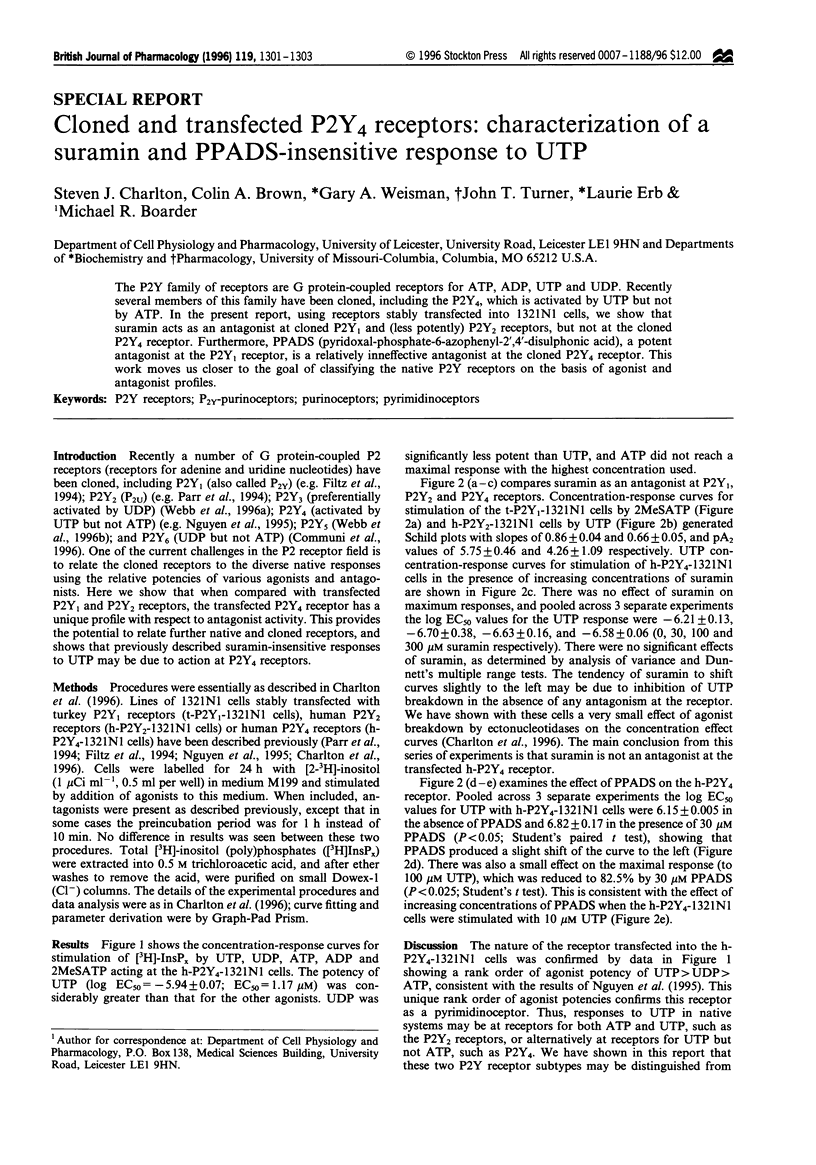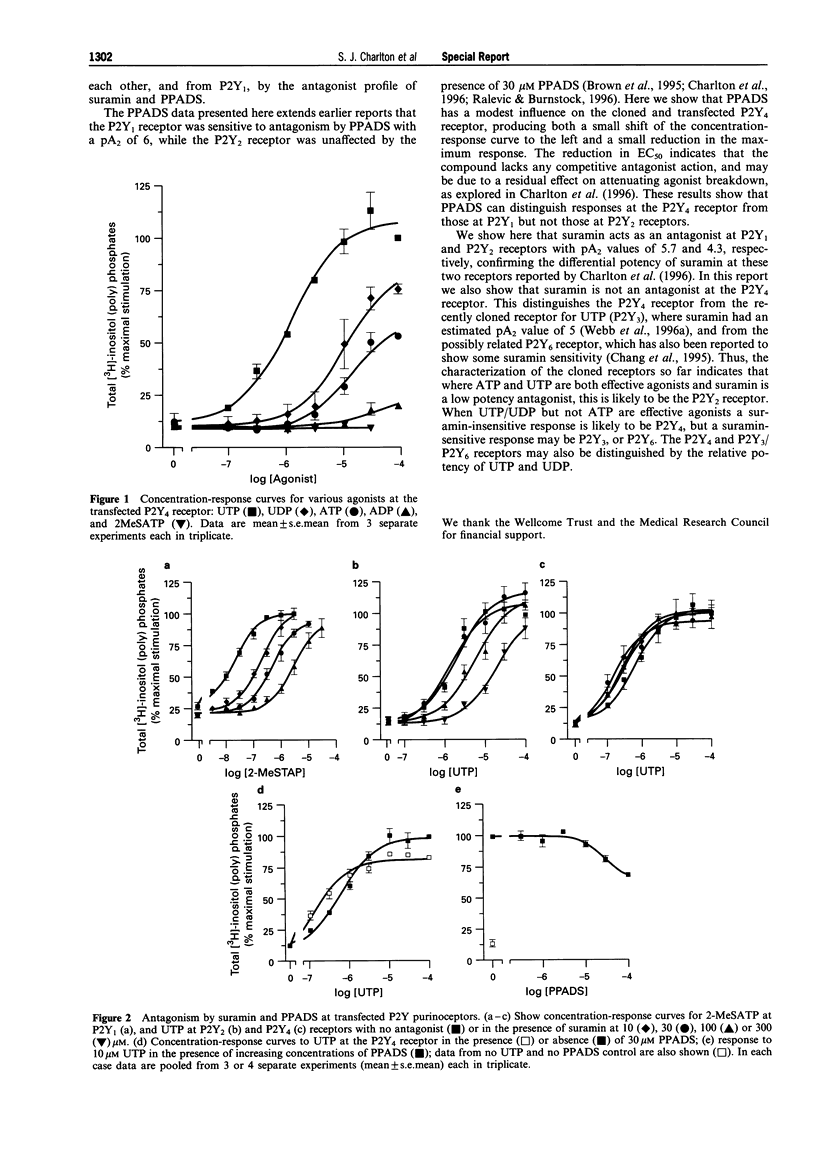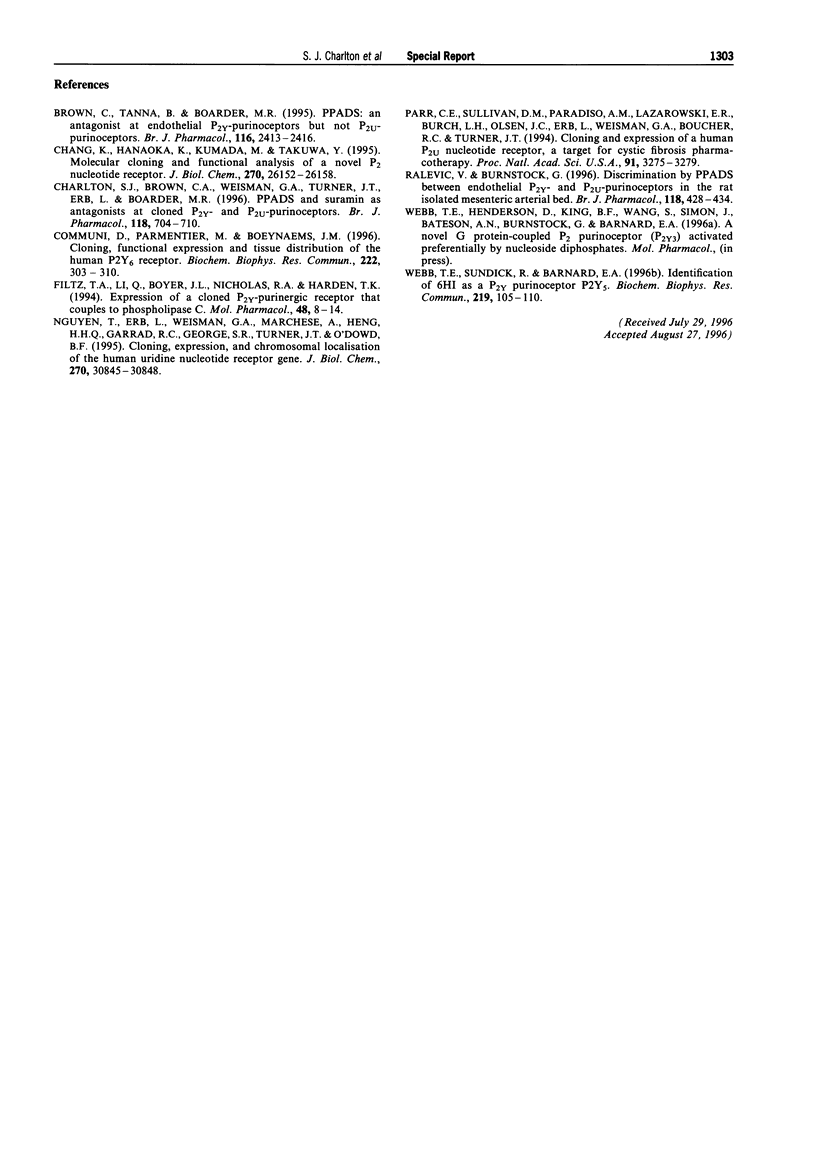Abstract
The P2Y family of receptors are G protein-coupled receptors for ATP, ADP, UTP and UDP. Recently several members of this family have been cloned, including the P2Y4, which is activated by UTP but not by ATP. In the present report, using receptors stably transfected into 1321N1 cells, we show that suramin acts as an antagonist at cloned P2Y1 and (less potently) P2Y2 receptors, but not at the cloned P2Y4 receptor. Furthermore, PPADS (pyridoxal-phosphate-6-azophenyl-2',4'-disulphonic acid), a potent antagonist at the P2Y1 receptor, is a relatively inneffective antagonist at the cloned P2Y4 receptor. This work moves us closer to the goal of classifying the native P2Y receptors on the basis of agonist and antagonist profiles.
Full text
PDF


Selected References
These references are in PubMed. This may not be the complete list of references from this article.
- Brown C., Tanna B., Boarder M. R. PPADS: an antagonist at endothelial P2Y-purinoceptors but not P2U-purinoceptors. Br J Pharmacol. 1995 Nov;116(5):2413–2416. doi: 10.1111/j.1476-5381.1995.tb15088.x. [DOI] [PMC free article] [PubMed] [Google Scholar]
- Chang K., Hanaoka K., Kumada M., Takuwa Y. Molecular cloning and functional analysis of a novel P2 nucleotide receptor. J Biol Chem. 1995 Nov 3;270(44):26152–26158. doi: 10.1074/jbc.270.44.26152. [DOI] [PubMed] [Google Scholar]
- Charlton S. J., Brown C. A., Weisman G. A., Turner J. T., Erb L., Boarder M. R. PPADS and suramin as antagonists at cloned P2Y- and P2U-purinoceptors. Br J Pharmacol. 1996 Jun;118(3):704–710. doi: 10.1111/j.1476-5381.1996.tb15457.x. [DOI] [PMC free article] [PubMed] [Google Scholar]
- Communi D., Parmentier M., Boeynaems J. M. Cloning, functional expression and tissue distribution of the human P2Y6 receptor. Biochem Biophys Res Commun. 1996 May 15;222(2):303–308. doi: 10.1006/bbrc.1996.0739. [DOI] [PubMed] [Google Scholar]
- Filtz T. M., Li Q., Boyer J. L., Nicholas R. A., Harden T. K. Expression of a cloned P2Y purinergic receptor that couples to phospholipase C. Mol Pharmacol. 1994 Jul;46(1):8–14. [PubMed] [Google Scholar]
- Nguyen T., Erb L., Weisman G. A., Marchese A., Heng H. H., Garrad R. C., George S. R., Turner J. T., O'Dowd B. F. Cloning, expression, and chromosomal localization of the human uridine nucleotide receptor gene. J Biol Chem. 1995 Dec 29;270(52):30845–30848. doi: 10.1074/jbc.270.52.30845. [DOI] [PubMed] [Google Scholar]
- Parr C. E., Sullivan D. M., Paradiso A. M., Lazarowski E. R., Burch L. H., Olsen J. C., Erb L., Weisman G. A., Boucher R. C., Turner J. T. Cloning and expression of a human P2U nucleotide receptor, a target for cystic fibrosis pharmacotherapy. Proc Natl Acad Sci U S A. 1994 Apr 12;91(8):3275–3279. doi: 10.1073/pnas.91.8.3275. [DOI] [PMC free article] [PubMed] [Google Scholar]
- Ralevic V., Burnstock G. Discrimination by PPADS between endothelial P2Y- and P2U-purinoceptors in the rat isolated mesenteric arterial bed. Br J Pharmacol. 1996 May;118(2):428–434. doi: 10.1111/j.1476-5381.1996.tb15420.x. [DOI] [PMC free article] [PubMed] [Google Scholar]
- Webb T. E., Kaplan M. G., Barnard E. A. Identification of 6H1 as a P2Y purinoceptor: P2Y5. Biochem Biophys Res Commun. 1996 Feb 6;219(1):105–110. doi: 10.1006/bbrc.1996.0189. [DOI] [PubMed] [Google Scholar]


